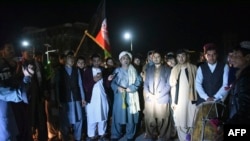In simultaneously issued statements, U.S. Secretary of State Michael Pompeo and the Taliban announced Friday that a deal between the U.S. and the Taliban will be signed February 29, paving the way toward ending the longest American war in history.
The deal calls for a phased withdrawal of all U.S. forces from Afghanistan in return for guarantees from the Taliban it will not allow Afghan soil to be used for terrorism, and it will participate in a reconciliation process with other Afghans.
“Intra-Afghan negotiations will start soon thereafter, and will build on this fundamental step to deliver a comprehensive and permanent cease-fire and the future political road map for Afghanistan,” Pompeo's statement said.
A signing ceremony is to be preceded by a seven-day reduction in violence period that began Saturday at midnight local time that will be observed by all parties to the conflict. All sides, U.S. forces, Taliban, and Afghan security forces, have clarified they reserve the right to respond to an attack.
The period is supposed to act as a confidence-building measure, as well as a gauge as to whether the Taliban have full control over their fighting forces.
“Both parties will now create a suitable security situation in advance of agreement signing date, extend invitations to senior representatives of numerous countries and organizations to participate in the signing ceremony,” a Taliban statement said.
The ceremony will be in Qatar’s capital, Doha, where the Taliban have maintained an unofficial political office for years, and where the two sides have engaged in negotiations for almost 18 months.
US to reduce forces
In the first phase, the U.S. is expected to reduce its forces from the current 13,000 to around 8,600. Barnett Rubin, a leading expert on Afghanistan who has advised the U.S. government on policy in the country, says a complete U.S. withdrawal will be linked to developments on the ground.
“The agreement overcomes mistrust by sequencing the components and stating that all are interdependent. As each measure is implemented, the parties will monitor compliance before taking the next step,” he wrote in his opinion piece in The Washington Post newspaper this week.
The Taliban also mentions making “arrangements for the release of prisoners,” a detail missing in the U.S. statement.
The deal is a culmination of years of efforts to bring the Taliban to the negotiating table. Earlier efforts failed because the U.S. wanted the Afghan government to be part of direct talks with the Taliban while the insurgent group refused to sit with what it claimed was a “puppet” regime without legitimacy.
2018 breakthrough
A breakthrough occurred in the summer of 2018 when high-level U.S. officials began meeting directly with the Taliban in Qatar, including U.S. Acting Assistant Secretary of State for South and Central Asia Alice Wells.
In September 2018, Zalmay Khalilzad was appointed as the U.S. special representative for Afghanistan reconciliation, and in October of that year he held his first official round of negotiation with the Taliban in Doha.
“When our representatives started negotiating with the United States in 2018, our confidence that the talks would yield results was close to zero,” Sirajuddin Haqqani, the deputy leader of the Taliban and the head of the deadly Haqqani network wrote in an opinion piece in The New York Times Thursday.
2019 setback
In September 2019, the two sides seemed ready to sign a deal. Severe criticism in the U.S. and Afghanistan generated by a perception the U.S. was cutting and running without guarantees of reduction in violence or human rights protection from the Taliban, coupled with bloody attacks by the Taliban that claimed an American life, led U.S. President Donald Trump to cancel the signing at the last minute.
While the deal signals the end of one phase of the Afghan wars, many Afghanistan experts say the real work of ending the conflict, which would require all Afghan factions to come to an understanding on the future framework of their country, is just beginning.
“Challenges remain, but the progress made in Doha provides hope and represents a real opportunity. The United States calls on all Afghans to seize this moment,” Pompeo said in his statement.









